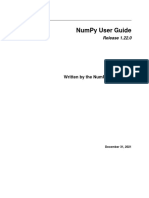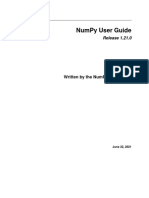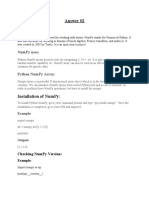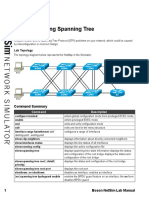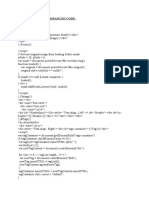NumPy (Numerical Python) is a Python library used for working with arrays and
mathematical operations. It is particularly useful for scientific computing and
data analysis.
Key Features and Uses:
General-purpose array-processing package: NumPy provides a high-performance
multidimensional array object and tools for working with these arrays.
Scientific Computing: NumPy is the fundamental package for scientific computing
with Python, offering tools for linear algebra, Fourier transforms, and random
number generation.
Machine Learning and Data Science: NumPy is widely used in machine learning and
data science applications due to its efficiency and flexibility.
Image and Signal Processing: NumPy is used in image and signal processing tasks due
to its ability to handle large arrays efficiently.
Quantum Computing: NumPy is also used in quantum computing due to its ability to
handle complex mathematical operations efficiently.
Performance
Faster Execution: NumPy arrays are optimized for complex mathematical and
statistical operations, making them up to 50x faster than traditional Python lists.
Memory Efficiency: NumPy arrays store homogenous data in contiguous blocks of
memory, making them more memory-efficient than Python lists.
Installation:
Mac and Linux: NumPy can be installed via pip using the command pip install numpy.
Windows: NumPy can be downloaded from the official website and installed manually.
Key Concepts
Nd array: NumPy's main object is the homogeneous multidimensional array, which is a
table of elements (usually numbers) indexed by a tuple of positive integers.
Broadcasting: NumPy allows element-wise operations between arrays of different
shapes through broadcasting.
Data Types: NumPy supports various data types, including integers, floating-point
numbers, and complex numbers.
Basic Operations
Basic Arithmetic Operations: NumPy supports basic arithmetic operations like
addition, subtraction, multiplication, and division, which can be performed
element-wise.
Advanced Operations: NumPy also supports advanced operations like matrix
multiplication, cumulative sum, and maximum/minimum values along specific axes.
Integration with Other Libraries
Pandas: NumPy is heavily used with the Pandas library for data manipulation and
analysis.
SciPy: NumPy is used with SciPy for scientific computing and signal processing
tasks.
Scikit-learn: NumPy is used with scikit-learn for machine learning tasks.
GitHub Repository
Source Code: The source code for NumPy is located at the official GitHub
repository: https://github.com/numpy/numpy.
installtion process
Sources
The installation process for NumPy involves several steps, depending on the
operating system and the method chosen. Here are the general steps for installing
NumPy on different platforms:
Installation Methods:
Using PIP:
Windows:
Open the command prompt.
Check if pip is installed by running pip --version.
Install NumPy using the command pip install numpy.
�Verify the installation by running python3 -c "import numpy;
print(numpy.__version__)".
MacOS:
Open the terminal.
Check if pip is installed by running pip3 --version.
Install NumPy using the command pip3 install numpy.
Verify the installation by running python3 -c "import numpy;
print(numpy.__version__)".
Ubuntu:
Open the terminal.
Install pip using the command apt install python-pip python-pip3.
Install NumPy using the command pip3 install numpy.
Verify the installation by running python3 -c "import numpy;
print(numpy.__version__)".
Fedora:
Open the terminal.
Install pip using the command pip install numpy.









































